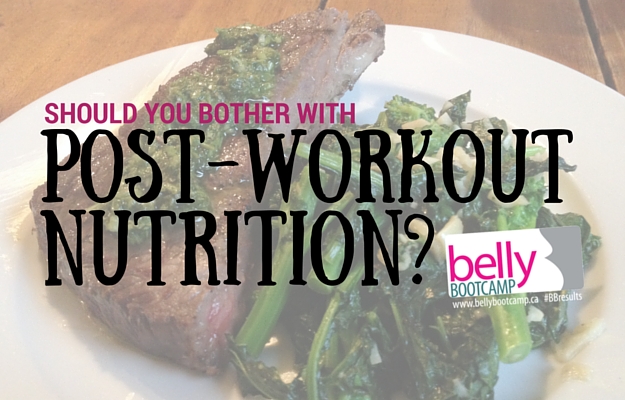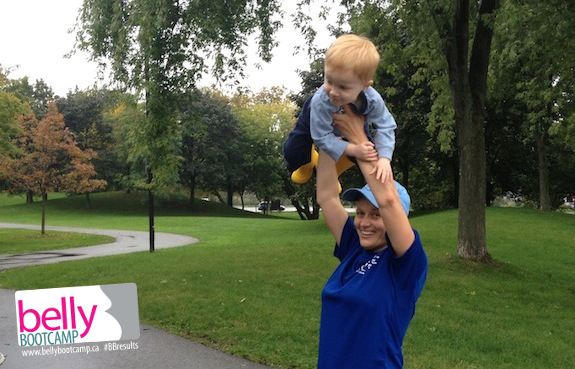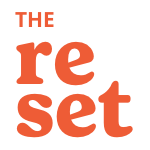
post-workout-nutrition
Quick! You’re done your Belly Bootcamp class or home workout and you need to eat, right? Save the shower, calling your girlfriend, and putting baby down for a nap. You need to stuff this protein bar into your face in the next 45 minutes or your workout efforts will be wasted! Right? Wrong.
THE “ANABOLIC WINDOW.”
When I was just a wee whippersnapper, training clients at a big gym, I would watch them walk out of our session and straight to the juice bar next door. Many would down a giant smoothie or a “healthy” muffin the size of roughly a watermelon. Burn 400 calories with your trainer, then eat 600 calories of muffin on the subway home? It was a constant frustration to the trainers. We watched our clients, feeling virtuous after a great workout, scarfing sugary post-workout snacks because they felt they had earned them. Plus, they could justify that big post-workout snack by eating within the “anabolic window” 15-45 minutes after a workout.
At some point, the bodybuilding culture of the 1990s crossed the threshold to mainstream culture, and “Bro Science” such as the post-workout anabolic window became widely known, misunderstood, and taken as gospel. It became common advice to eat within 45 minutes of every workout or risk missing out on any of the muscular adaptations you’d just slaved for in the gym. Writing it now, it sounds a little wacky. The human body is a much more intricate machine than the “anabolic window” might suggest, and we now know that exercise nutrition and food timing is not quite so cut and dried.
But, oh, the 90s. Who needs research when you have the finest human specimens on the earth to simply model yourself after? After all, if the leanest, most muscular people in the world ate immediately after working out, surely we all should too. And, surely, anything eaten within that anabolic window was going straight into “gains” and not to our asses.
Not so.

POST-WORKOUT FOOD MIGHT BE TOO MUCH FOOD.
Where we used to tell our clients to eat within 45 minutes, we now know that it’s more important your overall daily intake is sufficient if you want to build muscle. For the average exerciser with fat loss and muscle building goals, there are a few simple strategies that can help you get the nutrients you need.
If you are not training heavily more than one hour, 5-7 days per week, this is for you.
For example, maybe you…
- jog a few miles every morning
- do some strength training 5 days per week for about 30-60 minutes (If you’re chatting, resting, waiting for equipment, etc., you might spend 90 minutes in the gym but only exercise half that time!)
- walk with your little one a couple of hours every day
- practice pilates or yoga a few times each week
- play hockeyor [insert sport here] once or twice per week
If this — or some similar combination — sounds like your exercise routine, and/or:
- your primary focus is general fitness
- you are not training for a specific event or competition
- the intensity and length of your workouts is challenging but not extreme…
DO THIS.
Don’t sabotage your calorie burn.
After a cardio workout of roughly an hour or less, you do not need a post-workout meal. You have burned a few hundred calories, perhaps, which the body is apt to handle with its existing energy stores. Plus, a few hundred calories can very quickly be put back into your body with as little as 1 piece of bread & 2 tablespoons of peanut butter. If fat loss or body composition is a goal of yours, don’t eat just because you think you “should” or you “can.” Drink some water to rehydrate, which you should do immediately after exercising. Then, eat according to your hunger and/or at your next planned meal.
Do eat if you’ve been fasting before your workout.
If you’ve exercised on an empty stomach (usually this is first thing in the morning), do follow your workout with a balanced breakfast of protein, carbohydrate and fat. Time this meal within an hour of your workout and you’ll absorb the most possible carbohydrate into your muscles so you are better fuelled for the next time you exercise.
Time your workouts & meals.
Attempt to schedule your workouts so they fall before a regular meal time so you can enjoy the benefits of a post-workout meal without adding an additional meal (and those additonal calories) to your day. This is especially important if you are trying to lose body fat. Hit the gym after work, so your post-workout nutrition is easily covered by dinner a couple of hours later. Or do your home workout late morning and plan an awesome post-workout lunch!

toddler-workout
WHEN YOU DO GO HARD, HERE’S WHAT YOU NEED.
Maybe you’ve just run your first 15-kilometre charity race. Or maybe you jogged to your BB class, worked out like crazy and then walked home. After a longer, intense strength training workout or cardio session, your muscles are damaged and depleted by the work they have done and require the amino acids of protein to recover, plus the sugar of carbohydrate to store energy for your next session.
Focus on protein when planning a meal after your workout. A 1:1 or 2:1 carbohydrate to protein (in grams of carbohydrate versus grams of protein) ratio is good following an intense workout, or when planning your breakfast after a fasted morning run or workout.
Generally, at least 10-20 grams of protein is recommended (1/2 cup of cottage cheese, a few ounces of lean meat, a couple of eggs, etc.). If you can stomach more than this, go for it. And don’t be afraid of carbs! Carbohydrate consumed after a workout helps to utilize the post-workout protein and replenish stored energy in your muscles, so this is one time not to go all low-carb paleo.
BUT WHAT IF YOU’RE PREGNANT?
“Eating for two” really means eating for one, plus a wee bit extra. A post-workout snack can be a great time for those extra calories, in the form of a homemade protein shake or a half sandwich and a piece of fruit, for example. And, as long as you haven’t been advised otherwise by your midwife or doctor, you can continue to fuel after your workouts according to your hunger and by enjoying your next meal when the time comes, if you don’t feel hungry sooner. No need to stress about timing.
There is one major caveat. During pregnancy, we don’t recommend you participate in fasted workouts at any time.
If your usual workout time is 6 a.m. before work and before breakfast, ensure you and baby have a carbohydrate source to keep your blood sugar from dropping during your workout. Down a banana or a homemade muffin before you start, or enjoy a long, slow, warmup while you sip a smoothie. Follow your morning workout up with a great breakfast of protein, fat and carbohydrate.
AS WITH ALL THINGS…
Be honest with yourself. Don’t eat like a bodybuilder if you exercise like a bunny rabbit.
If you exercise recreationally, for short periods of time &/or below your maximal effort level, and especially if you primarily do cardio, focus on eating 3-4 good meals each day and drink to thirst.
